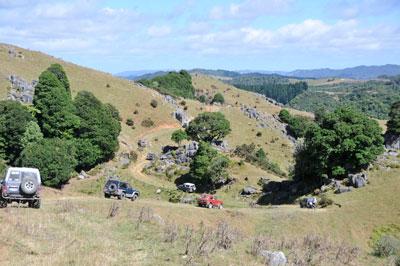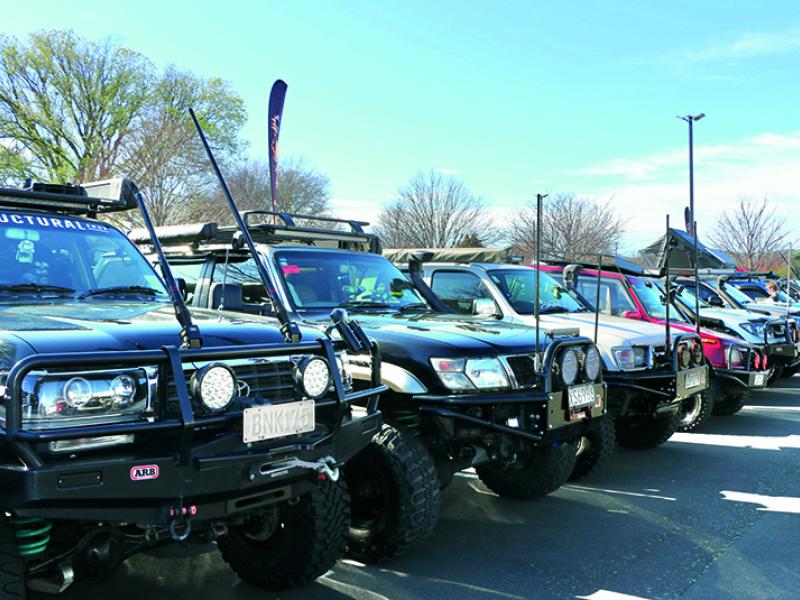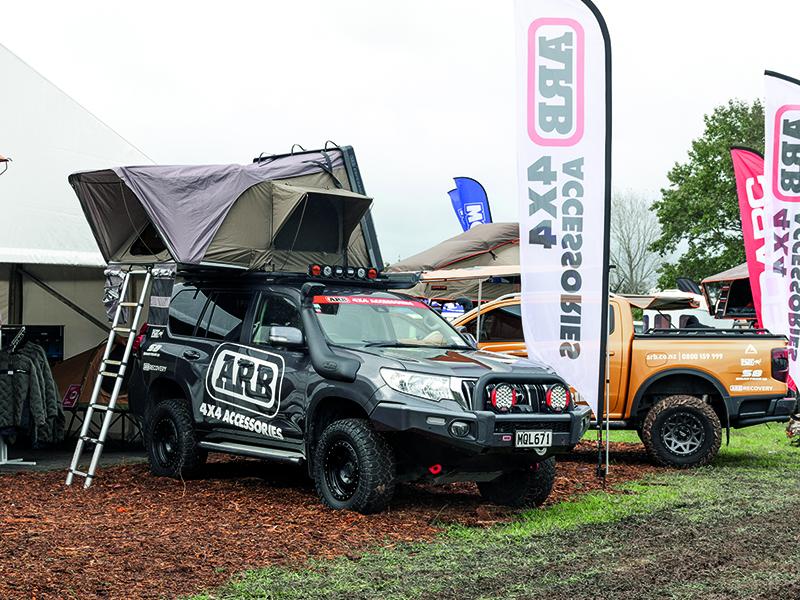This year’s Te Awamutu safari saw over 80 vehicles crossing private farms and taking in the unique scenery of the Waitomo area in Waikato. Back-country New Zealand at its best.
The annual 4WD Safari run by the Te Awamutu Rotary Club was this year based in Waitomo and therefore could be referred to as the Waitomo Safari. Once again the weekend was organised to their usual high standards, with central base and catering for all meals, if required, for the 82-plus vehicles and their occupants.
Waitomo comes from the Maori ‘wai’, which is water, and ‘tomo’ meaning hole or entrance, which translates to ‘stream that flows into the hole in the ground’, a meaning reflected in its fantastic geological history and landscape. The Waitomo Caves is one of New Zealand's original tourist destinations because of the water seeping through the ground and then the limestone rock, eroding underground passageways over the centuries.
Saturday was always going to be a big day for the safari, with 60km of off-road tracks and farms to cover from Piripiri to nearly Marokopa via Kinohaku and south of the Taharoa iron sands. The day started off with low cloud and mist and organisers were concerned about how the weather would continue, but by mid-morning the cloud lifted and we enjoyed beautiful sunshine for the rest of the day.
Once again I took my father Colin along and there were a few people on the trip he knew. A couple of the properties were owned by friends and he had spent some time on the Haswell property, which was the second farm we crossed in the morning. In fact, the Haswell property was one I knew very well myself having spent several years four-wheeling on the top farm opening up tracks over 20 years ago. Many of the tracks we traversed through Tony Haswell’s farm we had once winched through, built log bridges and cleared trees and pongas, although you wouldn’t think so now. Tony had obviously done some work on these old tracks, making them wider and taken out the ruts and washouts we used to contend with.
The old Caterpillar D7 bulldozer with its old petrol start ‘donkey’ engine and cable operated blade was still sitting where it had been left some 15 years ago, now in a poor state of repair. We took time out to have a look over it, as Colin had worked in the bush on the Phillips’ property at Marokopa in the mid to late 1960s logging native timber in this very machine with Tom Slade, the former owner. Tony’s father Bill purchased the old bulldozer and it was used on the Haswell farms until Tony replaced it with a more ‘modern’ electric start machine.
Colin had even used this old D7 to improve what we used to call the ‘Access Track’ between the two Haswell farms, which used to be difficult to negotiate in wet weather. However, the track these days is well maintained and made for a pleasant bush drive and then down the hills to the stream.
As they say, a farmer’s work is never done and Tony Haswell and his mother Doreen were hard at work drenching sheep when we came past. Tony’s sister Jill was back home from Canada but left them to it and, along with a few other ‘locals’, joined in the safari for the day.
From the Haswell’s we went onto the Williamson’s farm and up the hills, and as the clouds had finally lifted we were treated to spectacular views of Kinohaku and Kawhia Harbour.
The safari kept heading in a westerly direction toward the coast just south of the Taharoa iron sands. Another property that provided amazing views and scenery was the Gallagher Farms property managed by David and Christine Green. This 4-5,000 acre property was well looked after and gave us coastal views including Lake Harihari before we dropped down beside the lake and then onto the black iron sands of Harihari Beach.
The last property of the day was that of Sid and Jan Mitchell, which has some 1,500 acres of bush, and our little information booklet advised us to watch out for the 60 emus that run naturally here. They are kept for no other reason than as an interest because of their amusing habits, but alas I didn’t see them.
During this bush drive there was a challenge for those who wanted to attempt a difficult muddy stream crossing. It was certainly interesting to watch the many attempts and failures that resulted in a tow strap recovery. Only three vehicles actually managed to successfully drive it, but none as impressive as Anita Browne in her father’s modified FJ40 Land Cruiser. She was told to ‘boot it’ and she did, all the way, with an impressive wheel standing exit. There was a loud bang when the wheels touched the ground and unfortunately the left front CV was broken. Having witnessed Colin Browne do something similar previously, which also resulted in a broken CV, all I can say is “like father, like daughter”, but Anita’s effort was much more spectacular.
Back at Waitomo we were treated to a spit roast dinner as we talked and discussed the day’s events and took a few more trips down memory lane.
Sunday’s properties were a little closer to base and started off on the 364 hectare farm of Willie Berkers and Jo Knight. The properties today weren’t necessarily as picturesque as the day before, but rocky outcrops and natural bush provided their own scenic opportunities. The limestone rock formations are what makes Waitomo unique and are generally only found in this area.
The convoy of vehicles arrived at the lunch stop too early, so we had plenty of time to have a cuppa and chat to other safari participants. Dad got speaking with Barry Tervit and Dave Fraser about the area, and it came to light that Dave has the neighbouring property at Marokopa to the old Phillips property with the old D7 bulldozer. Just shows us how small the world really is.
After lunch it was on to the last couple of properties, the 500 acre Geange farm, which has been in the family for over 102 years, and the 1,660 acre property of Ben and Rebecca Stubbs, which has been in the Stubbs family since 1914. The Stubbs’ property has natural beauty and many tomos, and also has a 17m limestone arch creating a natural bridge across the Mangapohue Stream – although in reality it is the remnants of a natural cave.
After negotiating the many limestone outcrops, some with a very tight fit, we were soon back out at the road. The safari for 2014 was over and we were saying our thank yous and goodbyes. Once again it was a great weekend with many memories flooding back, but it is doubtful we will get the opportunity again soon: after 12 years the Te Awamutu Rotary Safari is possibly another victim of the new Adventure and Outdoor Regulations 2011, which take full effect in November this year. The regulations mean safari organisers have to meet specific guidelines, be registered with the Ministry of Business, Innovation and Employment (formerly the Department of Labour) at a cost and also be audited, adding further significant costs for the organisers.
For the Te Awamutu Rotary, which uses the event to fundraise for their many community projects, the costs to comply with the regulations may just be too much to make it worthwhile.
Hopefully it won’t be the last, but special thanks must go to the huge team of members who put the trip together, their many helpers who prepared the route in advance, the sponsors and supporters and of course the many property owners who generously provided access to their land for our enjoyment.







